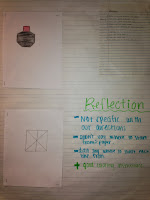I designed an activity where students researched the history of the atom and created interviews with the most influential scientists. They were required to write a script and use iPads to animate or record the interviews. The students were shown several iPad apps that would work well for this purpose. Most of them chose to use Puppet Pals. This is a great app that allows students to create animations using popular figures such as talk show hosts and political figures. A few students opted to use Educreations, iMovie, and ToonTastic.
Students truly seemed to enjoy this assignment and learned a great deal about the atom. Below is one of their videos. I was impressed with how well they did.
A few tips for having students create videos:
Students truly seemed to enjoy this assignment and learned a great deal about the atom. Below is one of their videos. I was impressed with how well they did.
A few tips for having students create videos:
- Require a written script. Students will try to wing it if you let them. This drags out the video making process and usually results in lower quality products.
- Play with the app ahead of time.
- Define how much time they will have for research/script writing and how much time they will have to produce the video.
- Have a class YouTube account set up for them to upload videos to. I don't recommend giving them the password to this account.
Do you have any suggestions of how to use videos in the classroom? Please share in the comments.









